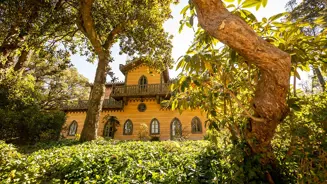The love story that the Portuguese rejected, but that Sintra embraced
14 Feb 2023

On Valentine's Day, we remember a love story between a king and a singer. A love story that, at the time, the Portuguese population rejected, but which ended up becoming one of the best known, as far as the Royal Family is concerned. And, of course, Sintra is at the centre of it all.
It was the year 1860. Verdi’s ‘A Masked Ball’ was on stage at the National Theatre of São Carlos in Lisbon. High society flocked to the performance venue - no one wanted to miss the best productions that arrived in Portugal. In the audience was King Ferdinand II, father of King Pedro V, King of Portugal, and widower of Queen Maria II, who died during the delivery of the couple's 11th child. The Artist King could not take his eyes off one of the performers - a woman, the Swiss opera singer Elise Hensler. The truth is that, a few months after this performance, Elise was already visiting the Necessidades Palace, the official residence of King Ferdinand.
But this love was not viewed favourably by society. The king-consort was 20 years older than the singer. Furthermore, he was the father of the king of Portugal - the relationship with an opera singer was regarded by many as somewhat discrediting for the Portuguese crown.
Ferdinand and Elise did their best to ignore the criticism. For this, they 'fled' from Lisbon and took refuge in the Park and Palace of Pena, owned by the Artist King. There, they could live together in love and isolated, without being disturbed.
But in reality, King Ferdinand was a public figure. Everyone wanted to know what the father of the King of Portugal was up to, what places he frequented, who he lived with. Indifferent to scrutiny, the couple lived a true love story: they spent long periods of time in Sintra, far from everything and everyone, dedicating themselves to their shared interests, such as literature, music and botany. Nine years after starting their relationship, the real proof of love arrived: Ferdinand and Elise were married in 1869, nine years after they met and with King Luís I already on the throne, Ferdinand and Elise tied the knot. The union took place days after Duke Ernst II of Saxe-Coburg and Gotha, at the request of his cousin King Ferdinand, granted Elise the title of Countess d'Edla.
As expected, the marriage was not well regarded by everyone: there were many among the nobility and in the press who raised their voices, criticising this union. But Ferdinand and Elise only had eyes for each other and for their shared project: the plantations at Pena Park and the construction of a chalet designed by the Countess herself. Strategically located to the west of the Palace of Pena, the building is inspired by alpine chalets in a style then very much in fashion across Europe. Ferdinand and Elise spent their days there, reading, having picnics, contemplating nature. It was there that they certainly experienced some of the happiest moments of their lives. Today, the Chalet of the Countess of Edla is one of the main points of interest in Sintra, visited by thousands of people every year.
The king and the countess lived together in love until the moment when death separated them. But even then, they were unable to avoid criticism: when Ferdinand died, in 1885, he left his assets, including the Moorish Castle and the Palace of Pena, to Elise in his will, but in the meantime legal proceedings were filed with the aim of passing this heritage into the hands of the Portuguese State. The reality is that Elise ended up selling the Park and Palace of Pena and the Moorish Castle to the Portuguese Crown, maintaining only the use of the chalet and its garden until 1904. After that, she left Sintra and went to live with her daughter Alice, from an earlier relationship, in Parede, Cascais. When she died in 1929, after the fall of the monarchy, she received the honours of a state figure.
